technical specifications FIAT IDEA 2008 1.G Owners Manual
[x] Cancel search | Manufacturer: FIAT, Model Year: 2008, Model line: IDEA, Model: FIAT IDEA 2008 1.GPages: 210, PDF Size: 3.64 MB
Page 105 of 210
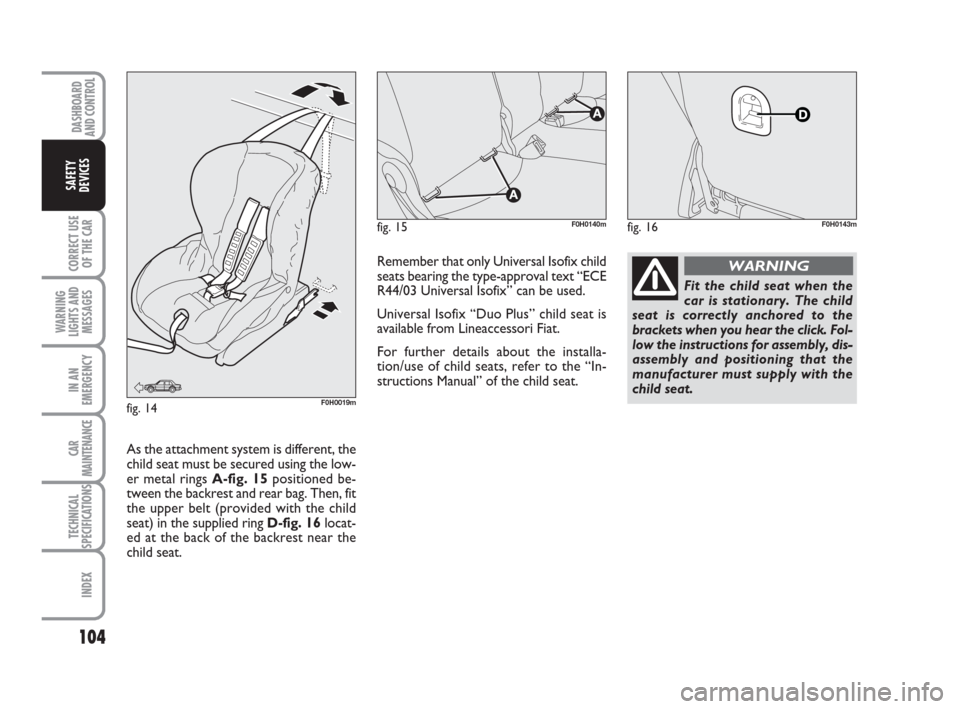
104
CORRECT USE
OF THE CAR
WARNING
LIGHTS AND
MESSAGES
IN AN
EMERGENCY
CAR
MAINTENANCE
TECHNICAL
SPECIFICATIONS
INDEX
DASHBOARD
AND CONTROL
SAFETY
DEVICES
fig. 15F0H0140m
Fit the child seat when the
car is stationary. The child
seat is correctly anchored to the
brackets when you hear the click. Fol-
low the instructions for assembly, dis-
assembly and positioning that the
manufacturer must supply with the
child seat.
WARNING
fig. 14F0H0019m
As the attachment system is different, the
child seat must be secured using the low-
er metal rings A-fig. 15positioned be-
tween the backrest and rear bag. Then, fit
the upper belt (provided with the child
seat) in the supplied ring D-fig. 16locat-
ed at the back of the backrest near the
child seat.
fig. 16F0H0143m
Remember that only Universal Isofix child
seats bearing the type-approval text “ECE
R44/03 Universal Isofix” can be used.
Universal Isofix “Duo Plus” child seat is
available from Lineaccessori Fiat.
For further details about the installa-
tion/use of child seats, refer to the “In-
structions Manual” of the child seat.
093-110 idea GB 1 ed 10-07-2008 8:28 Pagina 104
Page 106 of 210
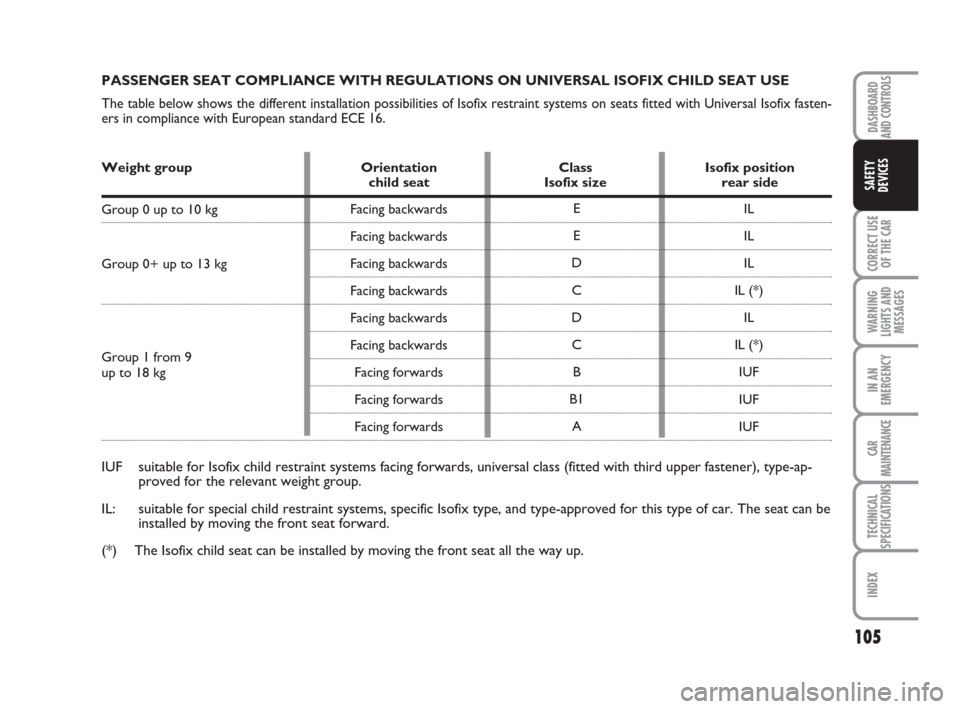
105
CORRECT USE
OF THE CAR
WARNING
LIGHTS AND
MESSAGES
IN AN
EMERGENCY
CAR
MAINTENANCE
TECHNICAL
SPECIFICATIONS
INDEX
DASHBOARD
AND CONTROLS
SAFETY
DEVICES
PASSENGER SEAT COMPLIANCE WITH REGULATIONS ON UNIVERSAL ISOFIX CHILD SEAT USE
The table below shows the different installation possibilities of Isofix restraint systems on seats fitted with Universal Isofix fasten-
ers in compliance with European standard ECE 16.
Weight group Orientation Class Isofix positionchild seat Isofix size rear side
Group 0 up to 10 kg
Group 0+ up to 13 kg
Group 1 from 9
up to 18 kg
Facing backwards
Facing backwards
Facing backwards
Facing backwards
Facing backwards
Facing backwards
Facing forwards
Facing forwards
Facing forwards E
E
D
C
D
C
B
B1
AIL
IL
IL
IL (*)
IL
IL (*)
IUF
IUF
IUF
IUF suitable for Isofix child restraint systems facing forwards, universal class (fitted with third upper fastener), type-ap-
proved for the relevant weight group.
IL: suitable for special child restraint systems, specific Isofix type, and type-approved for this type of car. The seat can be
installed by moving the front seat forward.
(*) The Isofix child seat can be installed by moving the front seat all the way up.
093-110 idea GB 1 ed 10-07-2008 8:28 Pagina 105
Page 107 of 210
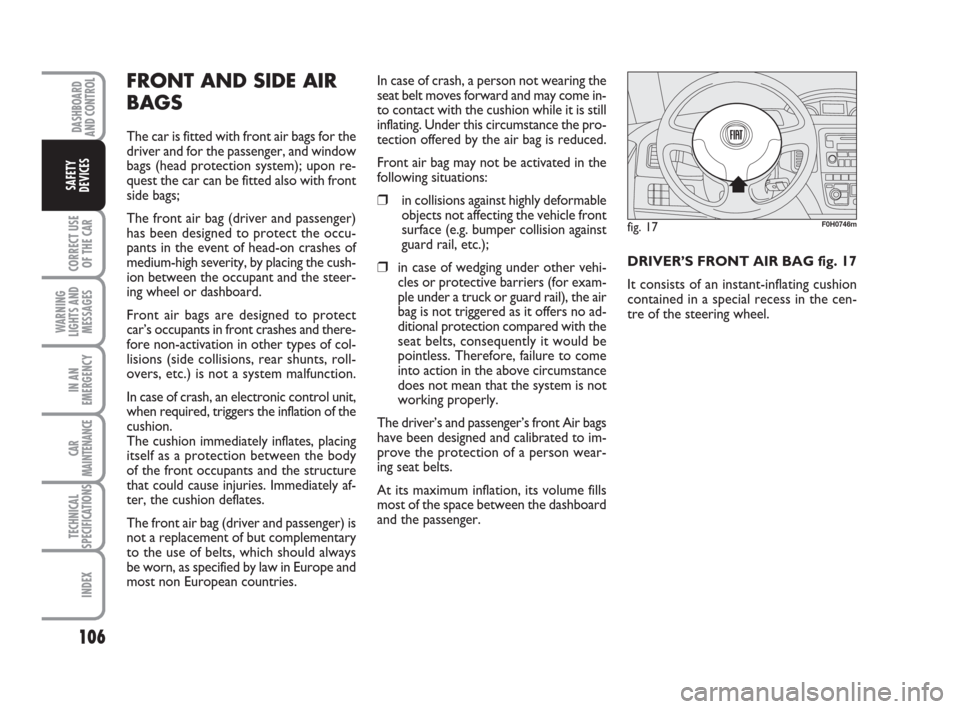
106
CORRECT USE
OF THE CAR
WARNING
LIGHTS AND
MESSAGES
IN AN
EMERGENCY
CAR
MAINTENANCE
TECHNICAL
SPECIFICATIONS
INDEX
DASHBOARD
AND CONTROL
SAFETY
DEVICES
FRONT AND SIDE AIR
BAGS
The car is fitted with front air bags for the
driver and for the passenger, and window
bags (head protection system); upon re-
quest the car can be fitted also with front
side bags;
The front air bag (driver and passenger)
has been designed to protect the occu-
pants in the event of head-on crashes of
medium-high severity, by placing the cush-
ion between the occupant and the steer-
ing wheel or dashboard.
Front air bags are designed to protect
car’s occupants in front crashes and there-
fore non-activation in other types of col-
lisions (side collisions, rear shunts, roll-
overs, etc.) is not a system malfunction.
In case of crash, an electronic control unit,
when required, triggers the inflation of the
cushion.
The cushion immediately inflates, placing
itself as a protection between the body
of the front occupants and the structure
that could cause injuries. Immediately af-
ter, the cushion deflates.
The front air bag (driver and passenger) is
not a replacement of but complementary
to the use of belts, which should always
be worn, as specified by law in Europe and
most non European countries.In case of crash, a person not wearing the
seat belt moves forward and may come in-
to contact with the cushion while it is still
inflating. Under this circumstance the pro-
tection offered by the air bag is reduced.
Front air bag may not be activated in the
following situations:
❒in collisions against highly deformable
objects not affecting the vehicle front
surface (e.g. bumper collision against
guard rail, etc.);
❒in case of wedging under other vehi-
cles or protective barriers (for exam-
ple under a truck or guard rail), the air
bag is not triggered as it offers no ad-
ditional protection compared with the
seat belts, consequently it would be
pointless. Therefore, failure to come
into action in the above circumstance
does not mean that the system is not
working properly.
The driver’s and passenger’s front Air bags
have been designed and calibrated to im-
prove the protection of a person wear-
ing seat belts.
At its maximum inflation, its volume fills
most of the space between the dashboard
and the passenger.DRIVER’S FRONT AIR BAG fig. 17
It consists of an instant-inflating cushion
contained in a special recess in the cen-
tre of the steering wheel.
fig. 17F0H0746m
093-110 idea GB 1 ed 10-07-2008 8:28 Pagina 106
Page 108 of 210
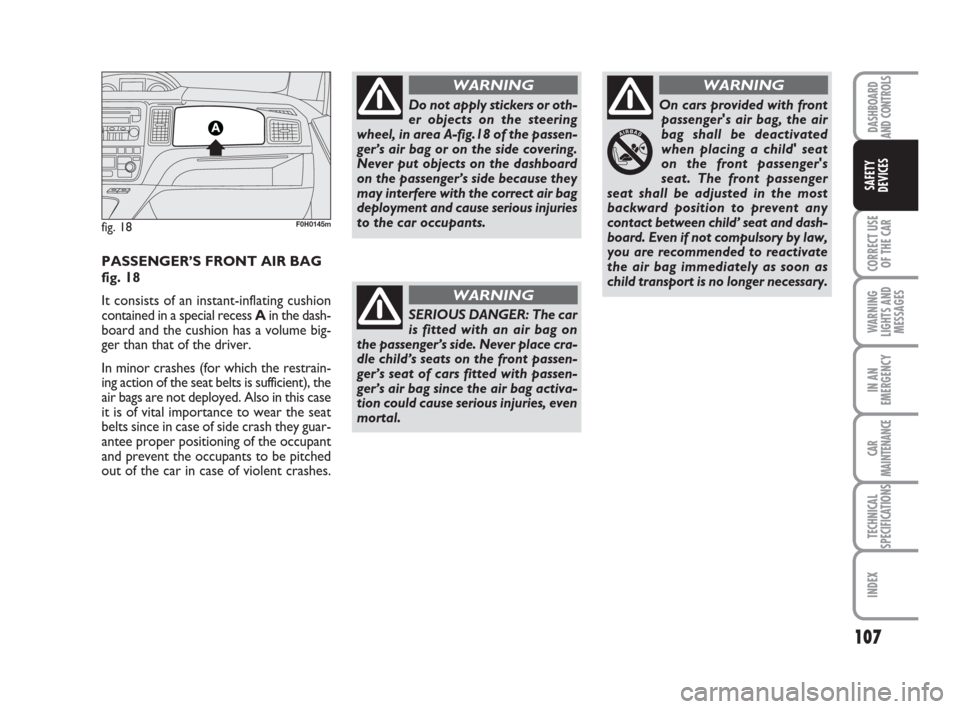
107
CORRECT USE
OF THE CAR
WARNING
LIGHTS AND
MESSAGES
IN AN
EMERGENCY
CAR
MAINTENANCE
TECHNICAL
SPECIFICATIONS
INDEX
DASHBOARD
AND CONTROLS
SAFETY
DEVICES
fig. 18F0H0145m
PASSENGER’S FRONT AIR BAG
fig. 18
It consists of an instant-inflating cushion
contained in a special recess Ain the dash-
board and the cushion has a volume big-
ger than that of the driver.
In minor crashes (for which the restrain-
ing action of the seat belts is sufficient), the
air bags are not deployed. Also in this case
it is of vital importance to wear the seat
belts since in case of side crash they guar-
antee proper positioning of the occupant
and prevent the occupants to be pitched
out of the car in case of violent crashes.
Do not apply stickers or oth-
er objects on the steering
wheel, in area A-fig.18 of the passen-
ger’s air bag or on the side covering.
Never put objects on the dashboard
on the passenger’s side because they
may interfere with the correct air bag
deployment and cause serious injuries
to the car occupants.
WARNING
SERIOUS DANGER: The car
is fitted with an air bag on
the passenger’s side. Never place cra-
dle child’s seats on the front passen-
ger’s seat of cars fitted with passen-
ger’s air bag since the air bag activa-
tion could cause serious injuries, even
mortal.
WARNING
On cars provided with front
passenger's air bag, the air
bag shall be deactivated
when placing a child' seat
on the front passenger's
seat. The front passenger
seat shall be adjusted in the most
backward position to prevent any
contact between child’ seat and dash-
board. Even if not compulsory by law,
you are recommended to reactivate
the air bag immediately as soon as
child transport is no longer necessary.
WARNING
093-110 idea GB 1 ed 10-07-2008 8:28 Pagina 107
Page 109 of 210
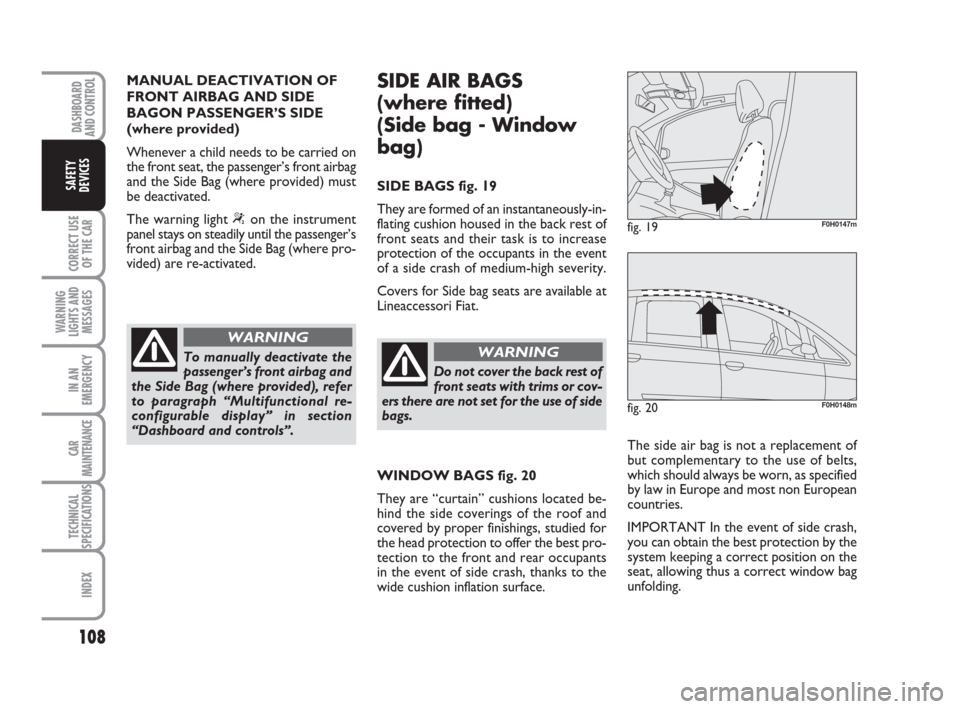
108
CORRECT USE
OF THE CAR
WARNING
LIGHTS AND
MESSAGES
IN AN
EMERGENCY
CAR
MAINTENANCE
TECHNICAL
SPECIFICATIONS
INDEX
DASHBOARD
AND CONTROL
SAFETY
DEVICES
To manually deactivate the
passenger’s front airbag and
the Side Bag (where provided), refer
to paragraph “Multifunctional re-
configurable display” in section
“Dashboard and controls”.
WARNING
MANUAL DEACTIVATION OF
FRONT AIRBAG AND SIDE
BAGON PASSENGER’S SIDE
(where provided)
Whenever a child needs to be carried on
the front seat, the passenger’s front airbag
and the Side Bag (where provided) must
be deactivated.
The warning light
“on the instrument
panel stays on steadily until the passenger’s
front airbag and the Side Bag (where pro-
vided) are re-activated.
SIDE AIR BAGS
(where fitted)
(Side bag - Window
bag)
SIDE BAGS fig. 19
They are formed of an instantaneously-in-
flating cushion housed in the back rest of
front seats and their task is to increase
protection of the occupants in the event
of a side crash of medium-high severity.
Covers for Side bag seats are available at
Lineaccessori Fiat.
The side air bag is not a replacement of
but complementary to the use of belts,
which should always be worn, as specified
by law in Europe and most non European
countries.
IMPORTANT In the event of side crash,
you can obtain the best protection by the
system keeping a correct position on the
seat, allowing thus a correct window bag
unfolding.
Do not cover the back rest of
front seats with trims or cov-
ers there are not set for the use of side
bags.
WARNING
WINDOW BAGS fig. 20
They are “curtain” cushions located be-
hind the side coverings of the roof and
covered by proper finishings, studied for
the head protection to offer the best pro-
tection to the front and rear occupants
in the event of side crash, thanks to the
wide cushion inflation surface.
fig. 19F0H0147m
fig. 20F0H0148m
093-110 idea GB 1 ed 10-07-2008 8:28 Pagina 108
Page 110 of 210

109
CORRECT USE
OF THE CAR
WARNING
LIGHTS AND
MESSAGES
IN AN
EMERGENCY
CAR
MAINTENANCE
TECHNICAL
SPECIFICATIONS
INDEX
DASHBOARD
AND CONTROLS
SAFETY
DEVICES
IMPORTANT The front air bags and/or
side bags may be deployed if the car is sub-
ject to heavy knocks or accidents involv-
ing the underbody area, such as for ex-
ample violent shocks against steps, kerbs
or low obstacles, falling of the car in big
holes or sags in the road.
IMPORTANT When the air bag inflates
it emits a small amount of dusts. These
dusts are harmless and is not the begin-
ning of a fire; then the unfold cushion sur-
face and the car interiors can be covered
by a dusty remains: this dust can irritate
skin and eyes. In case of contact, wash
yourself using neutral soap and water.
The air bag system has a validity of 14
years as to the pyrotechnic charge, and 10
years as to the twisted contact. As this
date approaches, contact Fiat Dealership
to have it replaced.
IMPORTANT Should an accident occur in
which any of the safety devices is activat-
ed, take the car to a Fiat Dealership to
have the devices activated replaced and to
have the system checked.
All check, repair and replacement opera-
tions concerning the air bags must only be
carried out c/o Fiat Dealership.If you are having the car scrapped, have
the air bag system deactivated at a Fiat
Dealership first. If the car changes own-
ership, the new owner must be informed
of the method of use of air bags and the
above warnings and also be given this
“Owner handbook”.
IMPORTANT The triggering of preten-
sioners, front air bags and front side bags
is decided in a differentiated manner. The
failure to deploy one or more of them
does not mean that the system is not
working properly.
Never rest head, arms and
elbows on the door, on the
windows and in the window bag area
to prevent possible injuries during the
inflation phase.
WARNING
Never put head, arms and el-
bows out of the window.
WARNING
If warning light ¬does not
come on when turning the
key to MAR or if it stays on when
travelling it could indicate a failure in
restraint systems; in this case air bags
or pretensioners could not trigger in
the event of an accident, or in a re-
stricted numbers of cases they could
trigger accidentally. Stop the car and
contact Fiat Dealership to have the
system checked immediately.
WARNING
GENERAL WARNINGS
Do not cover the back rest of
front seats with trims or cov-
ers there are not set for the use of side
bags.
WARNING
Always keep your hands on
the steering wheel rim when
driving, so that if the air bag is trig-
gered, it can inflate without meeting
any obstacles which could cause seri-
ous harm to you. Do not drive with
the body bent forwards, keep the seat
back rest in the erect position and
lean your back well against it.
WARNING
093-110 idea GB 1 ed 10-07-2008 8:28 Pagina 109
Page 111 of 210
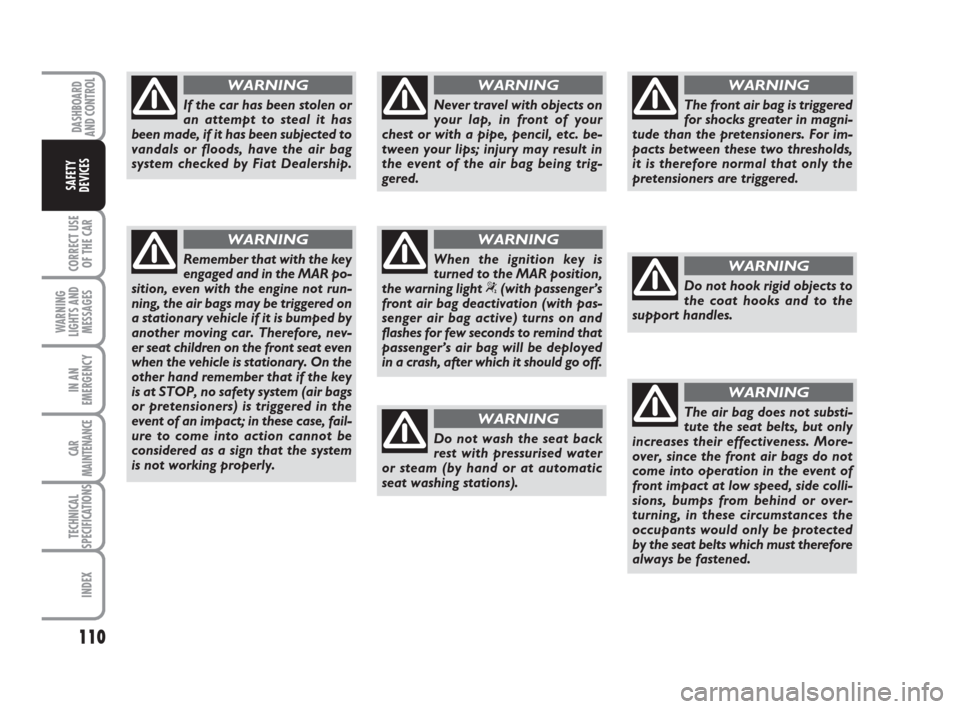
110
CORRECT USE
OF THE CAR
WARNING
LIGHTS AND
MESSAGES
IN AN
EMERGENCY
CAR
MAINTENANCE
TECHNICAL
SPECIFICATIONS
INDEX
DASHBOARD
AND CONTROL
SAFETY
DEVICES
If the car has been stolen or
an attempt to steal it has
been made, if it has been subjected to
vandals or floods, have the air bag
system checked by Fiat Dealership.
WARNING
Remember that with the key
engaged and in the MAR po-
sition, even with the engine not run-
ning, the air bags may be triggered on
a stationary vehicle if it is bumped by
another moving car. Therefore, nev-
er seat children on the front seat even
when the vehicle is stationary. On the
other hand remember that if the key
is at STOP, no safety system (air bags
or pretensioners) is triggered in the
event of an impact; in these case, fail-
ure to come into action cannot be
considered as a sign that the system
is not working properly.
WARNING
Never travel with objects on
your lap, in front of your
chest or with a pipe, pencil, etc. be-
tween your lips; injury may result in
the event of the air bag being trig-
gered.
WARNING
When the ignition key is
turned to the MAR position,
the warning light “(with passenger’s
front air bag deactivation (with pas-
senger air bag active) turns on and
flashes for few seconds to remind that
passenger’s air bag will be deployed
in a crash, after which it should go off.
WARNING
Do not wash the seat back
rest with pressurised water
or steam (by hand or at automatic
seat washing stations).
WARNING
The front air bag is triggered
for shocks greater in magni-
tude than the pretensioners. For im-
pacts between these two thresholds,
it is therefore normal that only the
pretensioners are triggered.
WARNING
Do not hook rigid objects to
the coat hooks and to the
support handles.
WARNING
The air bag does not substi-
tute the seat belts, but only
increases their effectiveness. More-
over, since the front air bags do not
come into operation in the event of
front impact at low speed, side colli-
sions, bumps from behind or over-
turning, in these circumstances the
occupants would only be protected
by the seat belts which must therefore
always be fastened.
WARNING
093-110 idea GB 1 ed 10-07-2008 8:28 Pagina 110
Page 112 of 210
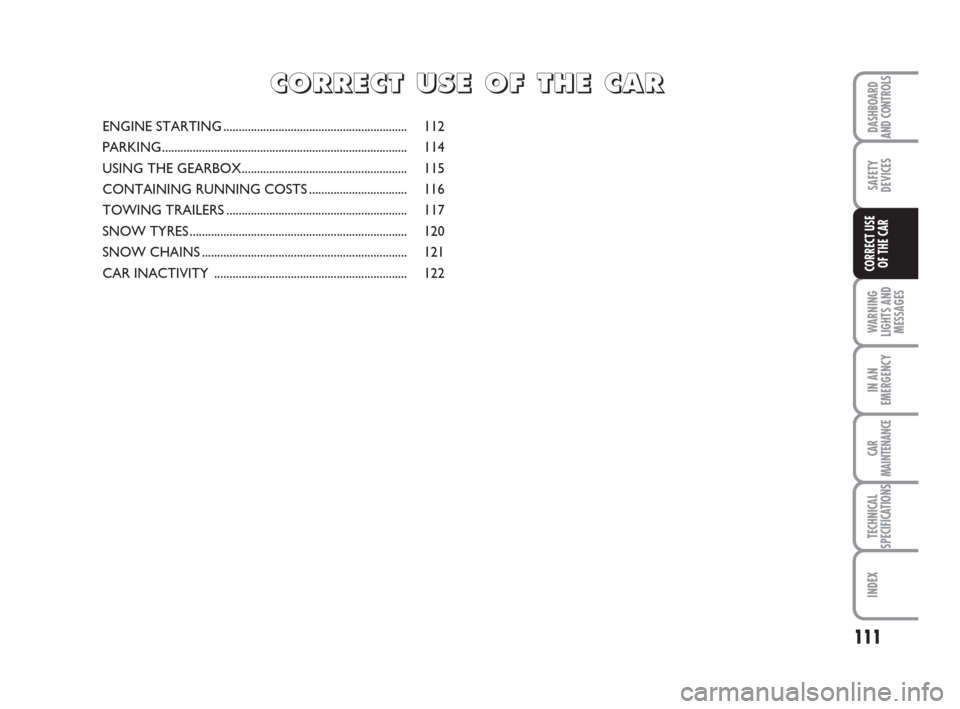
111
WARNING
LIGHTS AND
MESSAGES
IN AN
EMERGENCY
CAR
MAINTENANCE
TECHNICAL
SPECIFICATIONS
INDEX
DASHBOARD
AND CONTROLS
SAFETY
DEVICES
CORRECT USE
OF THE CAR
ENGINE STARTING ............................................................ 112
PARKING ................................................................................ 114
USING THE GEARBOX...................................................... 115
CONTAINING RUNNING COSTS ................................ 116
TOWING TRAILERS ........................................................... 117
SNOW TYRES ....................................................................... 120
SNOW CHAINS ................................................................... 121
CAR INACTIVITY ............................................................... 122
CC C
O O
R R
R R
E E
C C
T T
U U
S S
E E
O O
F F
T T
H H
E E
C C
A A
R R
111-122 idea GB 1 ed 10-07-2008 8:29 Pagina 111
Page 113 of 210
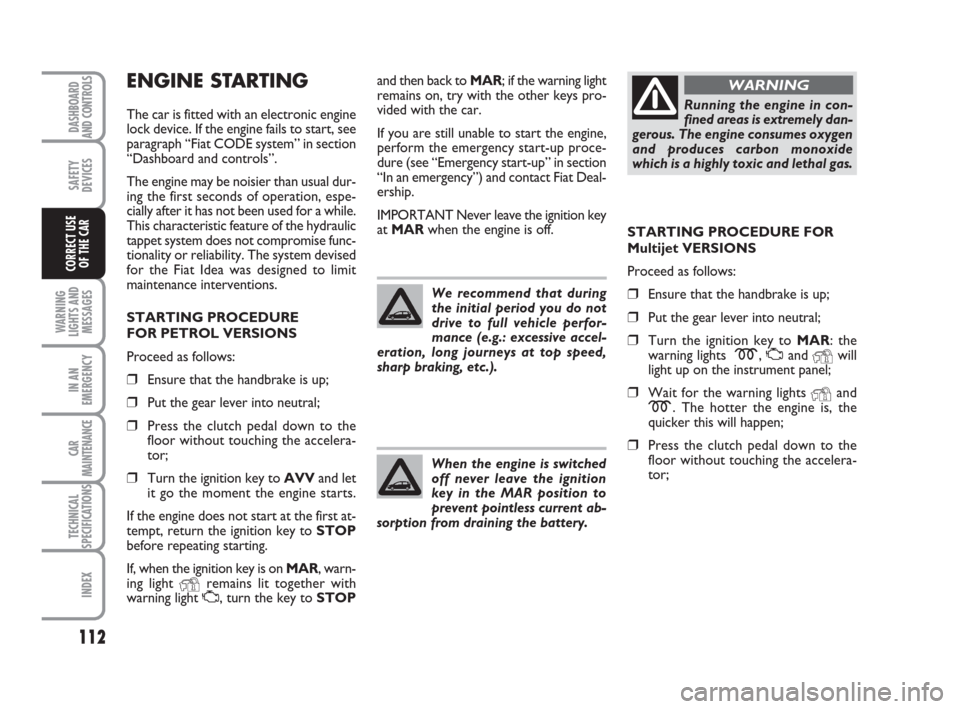
112
WARNING
LIGHTS AND
MESSAGES
IN AN
EMERGENCY
CAR
MAINTENANCE
TECHNICAL
SPECIFICATIONS
INDEX
DASHBOARD
AND CONTROLS
SAFETY
DEVICES
CORRECT USE
OF THE CAR
ENGINE STARTING
The car is fitted with an electronic engine
lock device. If the engine fails to start, see
paragraph “Fiat CODE system” in section
“Dashboard and controls”.
The engine may be noisier than usual dur-
ing the first seconds of operation, espe-
cially after it has not been used for a while.
This characteristic feature of the hydraulic
tappet system does not compromise func-
tionality or reliability. The system devised
for the Fiat Idea was designed to limit
maintenance interventions.
STARTING PROCEDURE
FOR PETROL VERSIONS
Proceed as follows:
❒Ensure that the handbrake is up;
❒Put the gear lever into neutral;
❒Press the clutch pedal down to the
floor without touching the accelera-
tor;
❒Turn the ignition key to AVVand let
it go the moment the engine starts.
If the engine does not start at the first at-
tempt, return the ignition key to STOP
before repeating starting.
If, when the ignition key is on MAR, warn-
ing light
Yremains lit together with
warning light U, turn the key to STOP
Running the engine in con-
fined areas is extremely dan-
gerous. The engine consumes oxygen
and produces carbon monoxide
which is a highly toxic and lethal gas.
WARNINGand then back to MAR; if the warning light
remains on, try with the other keys pro-
vided with the car.
If you are still unable to start the engine,
perform the emergency start-up proce-
dure (see “Emergency start-up” in section
“In an emergency”) and contact Fiat Deal-
ership.
IMPORTANT Never leave the ignition key
at MARwhen the engine is off.
STARTING PROCEDURE FOR
Multijet VERSIONS
Proceed as follows:
❒Ensure that the handbrake is up;
❒Put the gear lever into neutral;
❒Turn the ignition key to MAR: the
warning lights m, Uand
Ywill
light up on the instrument panel;
❒Wait for the warning lights Yand
m. The hotter the engine is, the
quicker this will happen;
❒Press the clutch pedal down to the
floor without touching the accelera-
tor; We recommend that during
the initial period you do not
drive to full vehicle perfor-
mance (e.g.: excessive accel-
eration, long journeys at top speed,
sharp braking, etc.).
When the engine is switched
off never leave the ignition
key in the MAR position to
prevent pointless current ab-
sorption from draining the battery.
111-122 idea GB 1 ed 10-07-2008 8:29 Pagina 112
Page 114 of 210
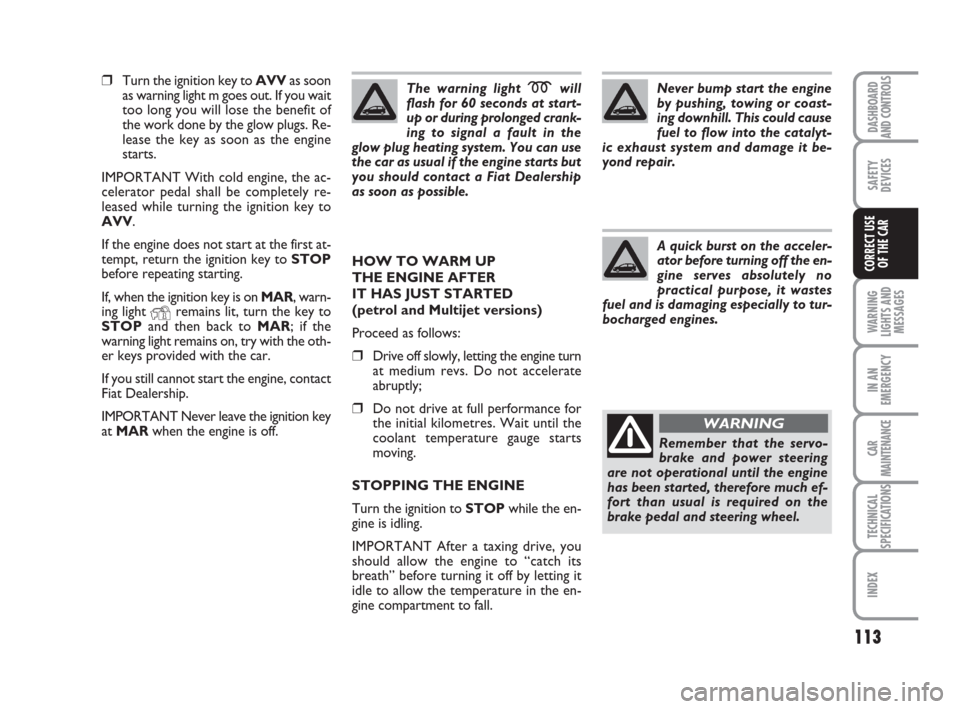
113
WARNING
LIGHTS AND
MESSAGES
IN AN
EMERGENCY
CAR
MAINTENANCE
TECHNICAL
SPECIFICATIONS
INDEX
DASHBOARD
AND CONTROLS
SAFETY
DEVICES
CORRECT USE
OF THE CAR
❒Turn the ignition key to AVVas soon
as warning light m goes out. If you wait
too long you will lose the benefit of
the work done by the glow plugs. Re-
lease the key as soon as the engine
starts.
IMPORTANT With cold engine, the ac-
celerator pedal shall be completely re-
leased while turning the ignition key to
AVV.
If the engine does not start at the first at-
tempt, return the ignition key to STOP
before repeating starting.
If, when the ignition key is on MAR, warn-
ing light
Yremains lit, turn the key to
STOPand then back to MAR; if the
warning light remains on, try with the oth-
er keys provided with the car.
If you still cannot start the engine, contact
Fiat Dealership.
IMPORTANT Never leave the ignition key
at MARwhen the engine is off.The warning light
mwill
flash for 60 seconds at start-
up or during prolonged crank-
ing to signal a fault in the
glow plug heating system. You can use
the car as usual if the engine starts but
you should contact a Fiat Dealership
as soon as possible.
HOW TO WARM UP
THE ENGINE AFTER
IT HAS JUST STARTED
(petrol and Multijet versions)
Proceed as follows:
❒Drive off slowly, letting the engine turn
at medium revs. Do not accelerate
abruptly;
❒Do not drive at full performance for
the initial kilometres. Wait until the
coolant temperature gauge starts
moving.
STOPPING THE ENGINE
Turn the ignition to STOPwhile the en-
gine is idling.
IMPORTANT After a taxing drive, you
should allow the engine to “catch its
breath” before turning it off by letting it
idle to allow the temperature in the en-
gine compartment to fall.Never bump start the engine
by pushing, towing or coast-
ing downhill. This could cause
fuel to flow into the catalyt-
ic exhaust system and damage it be-
yond repair.
A quick burst on the acceler-
ator before turning off the en-
gine serves absolutely no
practical purpose, it wastes
fuel and is damaging especially to tur-
bocharged engines.
Remember that the servo-
brake and power steering
are not operational until the engine
has been started, therefore much ef-
fort than usual is required on the
brake pedal and steering wheel.
WARNING
111-122 idea GB 1 ed 10-07-2008 8:29 Pagina 113